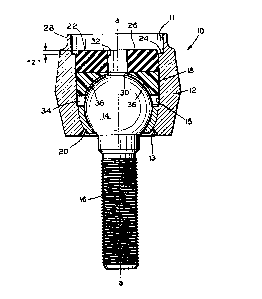Une partie des informations de ce site Web a été fournie par des sources externes. Le gouvernement du Canada n'assume aucune responsabilité concernant la précision, l'actualité ou la fiabilité des informations fournies par les sources externes. Les utilisateurs qui désirent employer cette information devraient consulter directement la source des informations. Le contenu fourni par les sources externes n'est pas assujetti aux exigences sur les langues officielles, la protection des renseignements personnels et l'accessibilité.
L'apparition de différences dans le texte et l'image des Revendications et de l'Abrégé dépend du moment auquel le document est publié. Les textes des Revendications et de l'Abrégé sont affichés :
| (12) Brevet: | (11) CA 1305200 |
|---|---|
| (21) Numéro de la demande: | 1305200 |
| (54) Titre français: | JOINT A ROTULE DE DIRECTION TARE ET METHODE CONNEXE |
| (54) Titre anglais: | PRELOADED STEERING BALL JOINT ASSEMBLY AND METHOD |
| Statut: | Durée expirée - après l'octroi |
| (51) Classification internationale des brevets (CIB): |
|
|---|---|
| (72) Inventeurs : |
|
| (73) Titulaires : |
|
| (71) Demandeurs : |
|
| (74) Agent: | SMART & BIGGAR LP |
| (74) Co-agent: | |
| (45) Délivré: | 1992-07-14 |
| (22) Date de dépôt: | 1988-11-14 |
| Licence disponible: | S.O. |
| Cédé au domaine public: | S.O. |
| (25) Langue des documents déposés: | Anglais |
| Traité de coopération en matière de brevets (PCT): | Non |
|---|
| (30) Données de priorité de la demande: | ||||||
|---|---|---|---|---|---|---|
|
Title
Preloaded Steering Ball Joint Assembly and Method
Abstract of the Invention
A preloaded steering ball joint assembly provides a system
wherein relatively constant torque may be realized over the
useful life of the joint. In a preferred form, the joint
assembly included a housing having a ball socket cavity, and a
ball and a shaft integral with the ball. Top and bottom bearing
seats are disposed for positioning and retaining the ball within
the housing. The bottom seat includes an aperture for permitting
passage of the shaft, while the top seat includes both an
aperture as well as radial passageways for permitting access of
lubricant into a lubricant chamber portion of the socket cavity.
A preferred method of manufacture includes insert molding an
elastomer disc over the top bearing seat by a pre-measured amount
of overfill, then after its formation compressing the elastomer
dics by means of a second disc made of metal by peening the
latter metallic disc over the elastomer disc. The metallic disc
is utilized to compress the predetermined "overfill" of
elastomer, which provides a mechanism by which consistency of
torque preload may be achieved in spite of tolerance variations
in part dimensions. Also, the top seat includes a barrier lip
which extends circumferentially about its upper surface for
preventing leakage of molten elastomer into the lubricant chamber
during the insert molding process.
Note : Les revendications sont présentées dans la langue officielle dans laquelle elles ont été soumises.
Note : Les descriptions sont présentées dans la langue officielle dans laquelle elles ont été soumises.

2024-08-01 : Dans le cadre de la transition vers les Brevets de nouvelle génération (BNG), la base de données sur les brevets canadiens (BDBC) contient désormais un Historique d'événement plus détaillé, qui reproduit le Journal des événements de notre nouvelle solution interne.
Veuillez noter que les événements débutant par « Inactive : » se réfèrent à des événements qui ne sont plus utilisés dans notre nouvelle solution interne.
Pour une meilleure compréhension de l'état de la demande ou brevet qui figure sur cette page, la rubrique Mise en garde , et les descriptions de Brevet , Historique d'événement , Taxes périodiques et Historique des paiements devraient être consultées.
| Description | Date |
|---|---|
| Inactive : Périmé (brevet sous l'ancienne loi) date de péremption possible la plus tardive | 2009-07-14 |
| Inactive : CIB de MCD | 2006-03-11 |
| Lettre envoyée | 2006-02-01 |
| Accordé par délivrance | 1992-07-14 |
Il n'y a pas d'historique d'abandonnement
| Type de taxes | Anniversaire | Échéance | Date payée |
|---|---|---|---|
| TM (catégorie 1, 5e anniv.) - générale | 1997-07-14 | 1997-06-18 | |
| TM (catégorie 1, 6e anniv.) - générale | 1998-07-14 | 1998-06-17 | |
| TM (catégorie 1, 7e anniv.) - générale | 1999-07-14 | 1999-06-16 | |
| TM (catégorie 1, 8e anniv.) - générale | 2000-07-14 | 2000-06-21 | |
| TM (catégorie 1, 9e anniv.) - générale | 2001-07-16 | 2001-06-20 | |
| TM (catégorie 1, 10e anniv.) - générale | 2002-07-15 | 2002-06-20 | |
| TM (catégorie 1, 11e anniv.) - générale | 2003-07-14 | 2003-06-20 | |
| TM (catégorie 1, 12e anniv.) - générale | 2004-07-14 | 2004-06-21 | |
| Enregistrement d'un document | 2005-04-12 | ||
| TM (catégorie 1, 13e anniv.) - générale | 2005-07-14 | 2005-06-22 | |
| TM (catégorie 1, 14e anniv.) - générale | 2006-07-14 | 2006-06-19 | |
| TM (catégorie 1, 15e anniv.) - générale | 2007-07-16 | 2007-06-18 | |
| TM (catégorie 1, 16e anniv.) - générale | 2008-07-14 | 2008-07-07 |
Les titulaires actuels et antérieures au dossier sont affichés en ordre alphabétique.
| Titulaires actuels au dossier |
|---|
| AFFINIA CANADA CORP. |
| Titulaires antérieures au dossier |
|---|
| KARLE O. KERN |